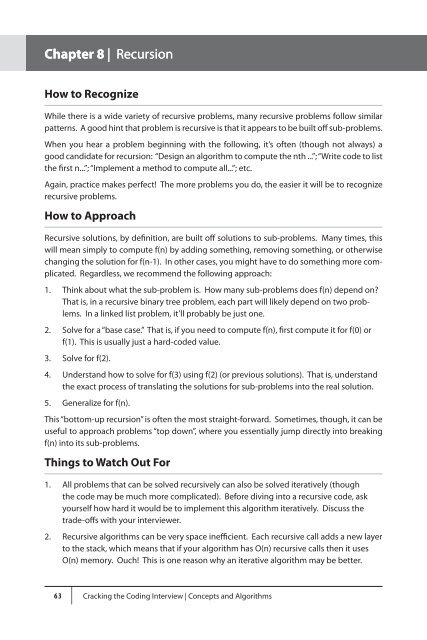Cracking the Coding Interview, 4 Edition - 150 Programming Interview Questions and Solutions
Cracking the Coding Interview, 4 Edition - 150 Programming Interview Questions and Solutions
Cracking the Coding Interview, 4 Edition - 150 Programming Interview Questions and Solutions
Create successful ePaper yourself
Turn your PDF publications into a flip-book with our unique Google optimized e-Paper software.
Chapter 8 | Recursion<br />
How to Recognize<br />
While <strong>the</strong>re is a wide variety of recursive problems, many recursive problems follow similar<br />
patterns. A good hint that problem is recursive is that it appears to be built off sub-problems.<br />
When you hear a problem beginning with <strong>the</strong> following, it’s often (though not always) a<br />
good c<strong>and</strong>idate for recursion: “Design an algorithm to compute <strong>the</strong> nth ...”; “Write code to list<br />
<strong>the</strong> first n...”; “Implement a method to compute all...”; etc.<br />
Again, practice makes perfect! The more problems you do, <strong>the</strong> easier it will be to recognize<br />
recursive problems.<br />
How to Approach<br />
Recursive solutions, by definition, are built off solutions to sub-problems. Many times, this<br />
will mean simply to compute f(n) by adding something, removing something, or o<strong>the</strong>rwise<br />
changing <strong>the</strong> solution for f(n-1). In o<strong>the</strong>r cases, you might have to do something more complicated.<br />
Regardless, we recommend <strong>the</strong> following approach:<br />
1. Think about what <strong>the</strong> sub-problem is. How many sub-problems does f(n) depend on?<br />
That is, in a recursive binary tree problem, each part will likely depend on two problems.<br />
In a linked list problem, it’ll probably be just one.<br />
2. Solve for a “base case.” That is, if you need to compute f(n), first compute it for f(0) or<br />
f(1). This is usually just a hard-coded value.<br />
3. Solve for f(2).<br />
4. Underst<strong>and</strong> how to solve for f(3) using f(2) (or previous solutions). That is, underst<strong>and</strong><br />
<strong>the</strong> exact process of translating <strong>the</strong> solutions for sub-problems into <strong>the</strong> real solution.<br />
5. Generalize for f(n).<br />
This “bottom-up recursion” is often <strong>the</strong> most straight-forward. Sometimes, though, it can be<br />
useful to approach problems “top down”, where you essentially jump directly into breaking<br />
f(n) into its sub-problems.<br />
Things to Watch Out For<br />
1. All problems that can be solved recursively can also be solved iteratively (though<br />
<strong>the</strong> code may be much more complicated). Before diving into a recursive code, ask<br />
yourself how hard it would be to implement this algorithm iteratively. Discuss <strong>the</strong><br />
trade-offs with your interviewer.<br />
2. Recursive algorithms can be very space inefficient. Each recursive call adds a new layer<br />
to <strong>the</strong> stack, which means that if your algorithm has O(n) recursive calls <strong>the</strong>n it uses<br />
O(n) memory. Ouch! This is one reason why an iterative algorithm may be better.<br />
6 3<br />
<strong>Cracking</strong> <strong>the</strong> <strong>Coding</strong> <strong>Interview</strong> | Concepts <strong>and</strong> Algorithms


